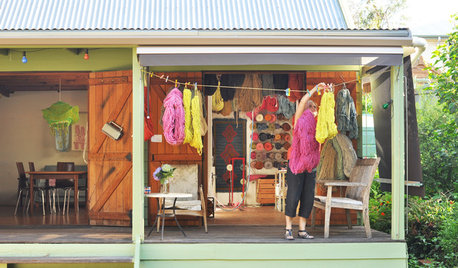Lawn colorant or dye
catheemivelaz
13 years ago
Related Stories

REMODELING GUIDESPro Finishing Secret: Aniline Dye for Wood
Deeper and richer than any stain, aniline dye gives wood stunningly deep color and a long-lasting finish
Full Story
RUGSOn Trend: Antique Rugs to Dye For
Saturate a well-worn Turkish rug with vibrant colors, and what do you get? A floor covering that celebrates old and new
Full Story
DECORATING GUIDESOn Trend: 10 Ways to Dip Dye
This fresh take on color adds splashes of style all around the house, from kitchen stools to bedding
Full Story
DECORATING GUIDESTwist Up a Room's Look With Tie-Dye
Dip into the organic patterns of tie-dye for one-of-a-kind style that can be — yes, you're hearing it right — thoroughly modern
Full Story
DECORATING GUIDESRetro Chic: The Return of Tie-Dye Decor
See how this psychedelic trend is making its mark in home decorating
Full Story
DECORATING GUIDES8 Ways to Decorate With Indigo Tie-Dye
Make a statement big or small using this fabric rooted in an ancient Japanese art form
Full Story
STUDIOS AND WORKSHOPSColorful Home Studio of a Dyed-in-the-Wool Textile Artist
An Australian rug maker dyes her own yarn and makes hand-tufted rugs in her cottage-style backyard space
Full Story
LANDSCAPE DESIGNGet Along With Less Lawn — Ideas to Save Water and Effort
Ditch the mower and lower your water bill while creating a feast for the eyes with diverse plantings and gathering places
Full Story
COLOROpposites Attract: Complementary Color Combos
Use the power couples of the color wheel — blue and orange, purple and yellow, red and green — to spice up any decor scheme
Full Story
BEFORE AND AFTERSSee 6 Yards Transformed by Losing Their Lawns
Wondering whether a turf lawn is the best use of your outdoor space? These homeowners did, and they found creative alternatives
Full StoryMore Discussions







andy10917
kevingalaxy
Related Professionals
Mitchellville Landscape Architects & Landscape Designers · Mount Wilson Landscape Architects & Landscape Designers · Buford Landscape Contractors · Brookline Landscape Contractors · Centereach Landscape Contractors · Leicester Landscape Contractors · Plymouth Landscape Contractors · Thonotosassa Landscape Contractors · Vancouver Landscape Contractors · West Allis Landscape Contractors · West Haverstraw Landscape Contractors · Goldenrod Landscape Contractors · Montclair Swimming Pool Builders · Shady Hills Swimming Pool Builders · Sunny Isles Beach Swimming Pool Buildersfruitjarfla
dchall_san_antonio
catheemivelazOriginal Author
jordanz
catheemivelazOriginal Author
dchall_san_antonio
dwpc
gsledge
jordanz
catheemivelazOriginal Author
jordanz
catheemivelazOriginal Author
rcnaylor
graywings123